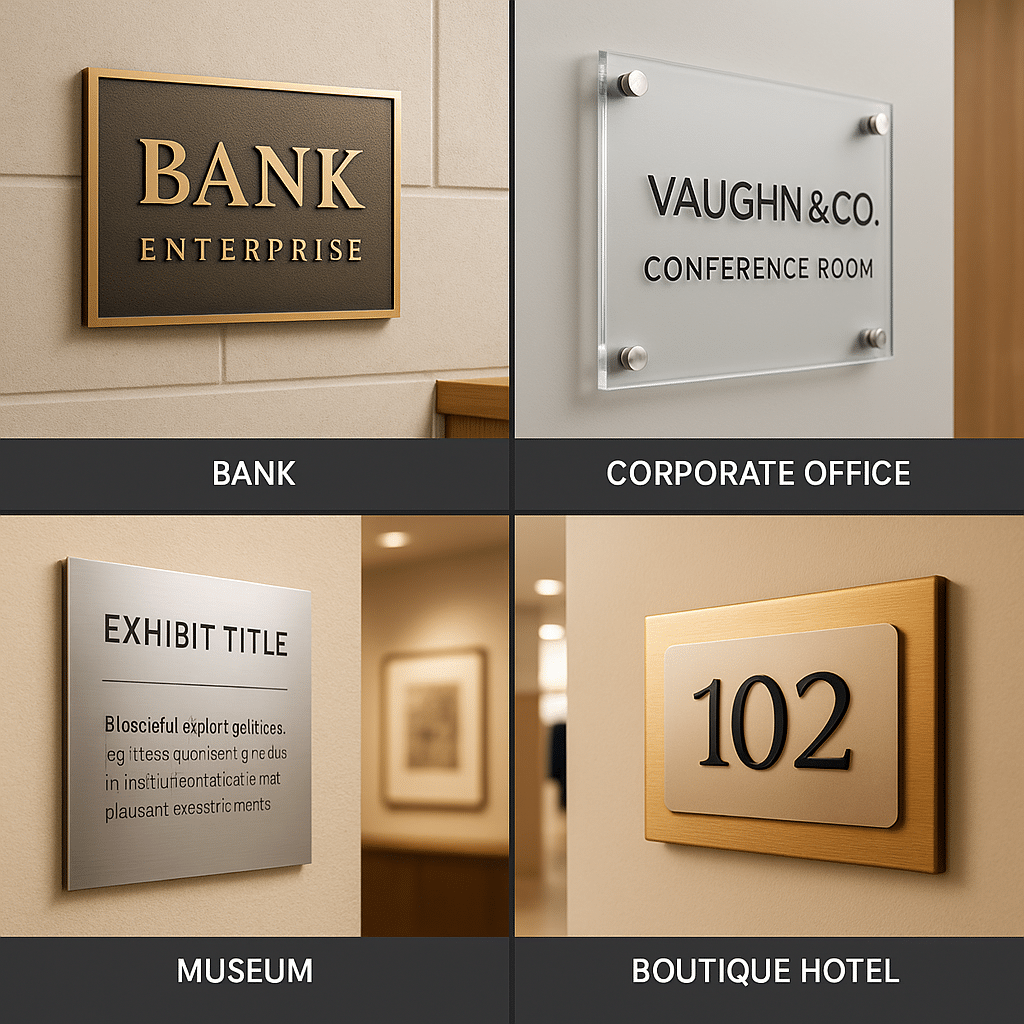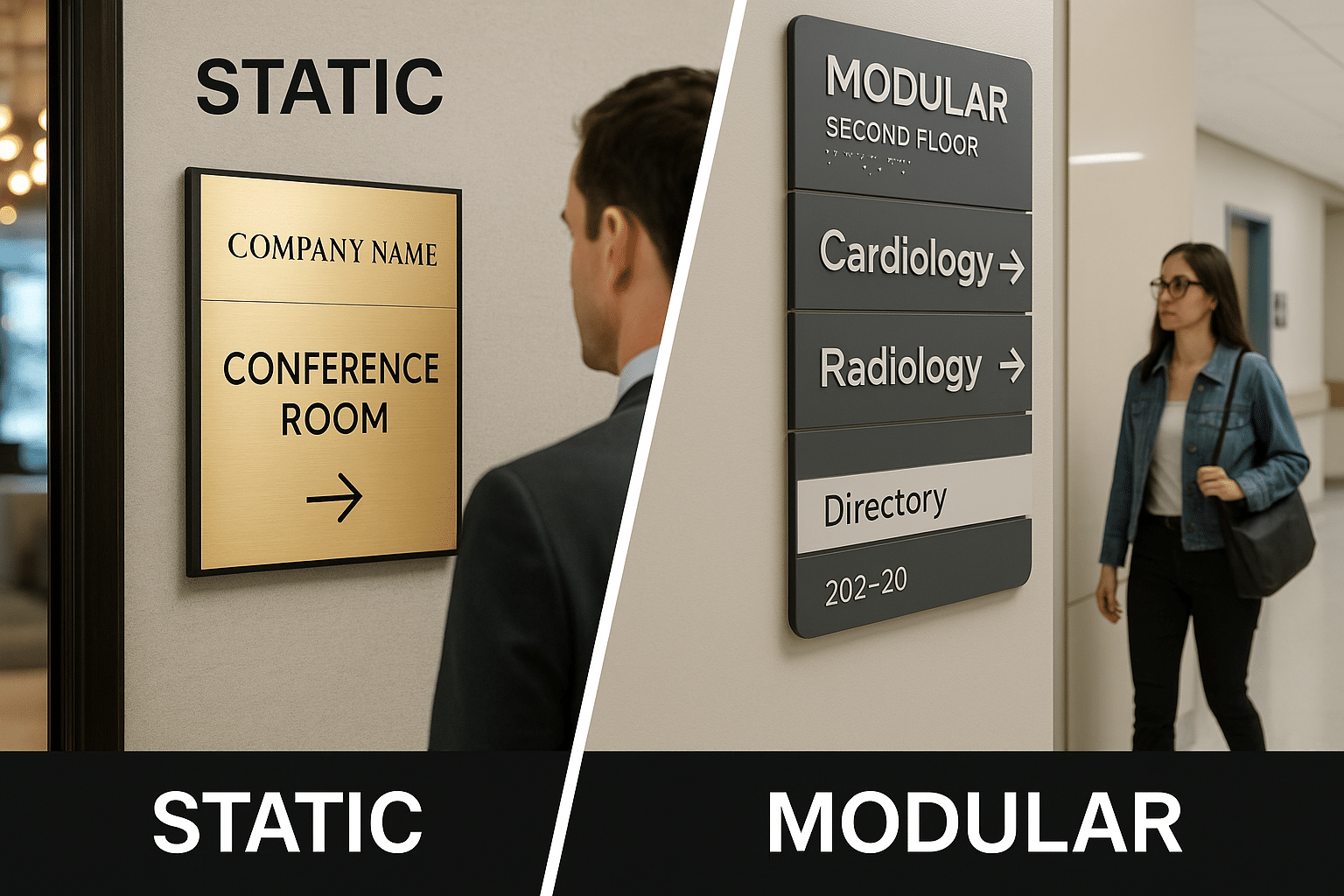Introduction
Imagine walking into a hospital, school, or office complex with no clear signage. Confusion sets in. Frustration grows. You’re late—and lost. That’s the real-life consequence of poor wayfinding.
Whether you’re outfitting a new building or revamping your facility’s signage, understanding the difference between static and modular wayfinding systems is crucial. This choice directly impacts user satisfaction, maintenance costs, and the flexibility of your signage.
In this article, we’ll break down everything you need to know—from functionality to aesthetics—to help you confidently choose the best solution for your business or organization.
What Are Static Wayfinding Systems?
A Permanent Fixture with Custom Appeal
Static wayfinding signs are custom-designed signs made for permanent installation. These signs don’t change often, and their content—be it text, arrows, or maps—is fixed in place. Think of engraved plaques, etched directories, or dimensional wall signs.
Use Cases
- Corporate offices
- Museums
- Retail stores
- Boutique hotels
Advantages of Static Wayfinding Signs
- Aesthetic Freedom: Custom materials, fonts, colors, and finishes allow full alignment with your brand identity.
- Durability: Often made from high-end materials like cast metal or acrylic, static signs are built to last.
- Professional Appeal: They offer a polished, timeless look—especially when used in premium architectural environments.
Drawbacks
- Limited Flexibility: Any change—like a new room name or department move—requires manufacturing a new sign.
- Higher Long-Term Costs: Ongoing updates mean more fabrication time and installation labor.

What Are Modular Wayfinding Systems?
A Smart, Scalable Solution
Modular wayfinding systems are made of interchangeable panels or inserts that allow for easy updates. These systems are designed to evolve with your space, making them ideal for buildings that experience frequent changes.
Use Cases
- Hospitals and healthcare facilities
- University campuses
- Airports
- Government buildings
Advantages of Modular Systems
- Update with Ease: No need for new signs—just swap out a panel or insert.
- Cost-Effective Over Time: Lower update costs reduce total ownership costs.
- Consistency Across Locations: Modular signs promote brand and design uniformity.
- ADA Compliance: Many modular systems can incorporate ADA compliant signs and tactile braille elements seamlessly.
Drawbacks
- Upfront Planning Required: You’ll need a system-level approach at the outset.
- Aesthetic Limitations: Modular signs can look more utilitarian if not thoughtfully designed.

Comparison Table: Static vs. Modular Wayfinding Systems
Feature |
Static Signs |
Modular Signs |
| Flexibility | Low | High |
| Cost Over Time | Higher (due to replacements) | Lower (easy updates) |
| Design Customization | High | Medium (depends on system) |
| Best For | Permanent signage needs | Dynamic, evolving environments |
| ADA Integration | Possible but fixed | Built-in and easily updated |
| Typical Use Cases | Hotels, museums, retail | Hospitals, campuses, offices |
Key Factors to Consider When Choosing a System
1. Traffic and Change Frequency
If your space frequently undergoes layout changes or department shifts, modular signage offers better ROI.
2. Aesthetic and Brand Alignment
High-end offices or boutique settings may prefer the custom look of static signs.
3. Budget Considerations
Static signs may be cheaper upfront but costlier to maintain. Modular systems often provide better total cost of ownership.
4. Compliance Needs
In regulated environments, such as healthcare and education, modular ADA compliant wayfinding systems make staying up to code easier.
Real-World Applications
Static Signage in Action: Boutique Hotel
A boutique hotel in Philadelphia used custom bronze plaques for room numbers and amenities. These custom wayfinding signs added elegance and fit the brand’s vintage aesthetic. However, the signs were expensive to replace when two room names changed after a rebrand.
Modular System Success: Regional Healthcare Facility
A hospital in Delaware implemented a modular signage system with ADA braille, color-coded directories, and easy-swap panels. As departments expanded, signage updates took minutes—not weeks. This adaptability minimized patient confusion and maximized operational efficiency.
Tupp Signs: Your Partner for Custom Wayfinding Solutions
At Tupp Signs, we understand that signage isn’t just about navigation—it’s about experience, identity, and functionality. Whether you need building navigation sign solutions, modular directory systems, or custom ADA signage, we’re here from design to installation.
We work with businesses, hospitals, and institutions across the Northeast and beyond, providing custom signage solutions tailored to their specific needs.
Conclusion
Choosing between static and modular wayfinding systems comes down to your space’s functionality, your branding goals, and how often things change. Static signs offer beauty and permanence. Modular signs offer flexibility and efficiency.
Both have their place—and both can be elevated with the right design and craftsmanship.
Ready to elevate your facility’s navigation experience?
📞 Contact Tupp Signs today for a free consultation or custom quote on your wayfinding signage project.


